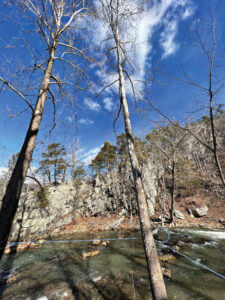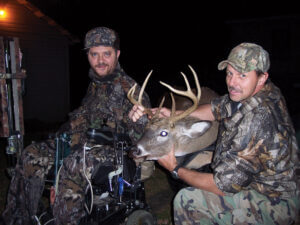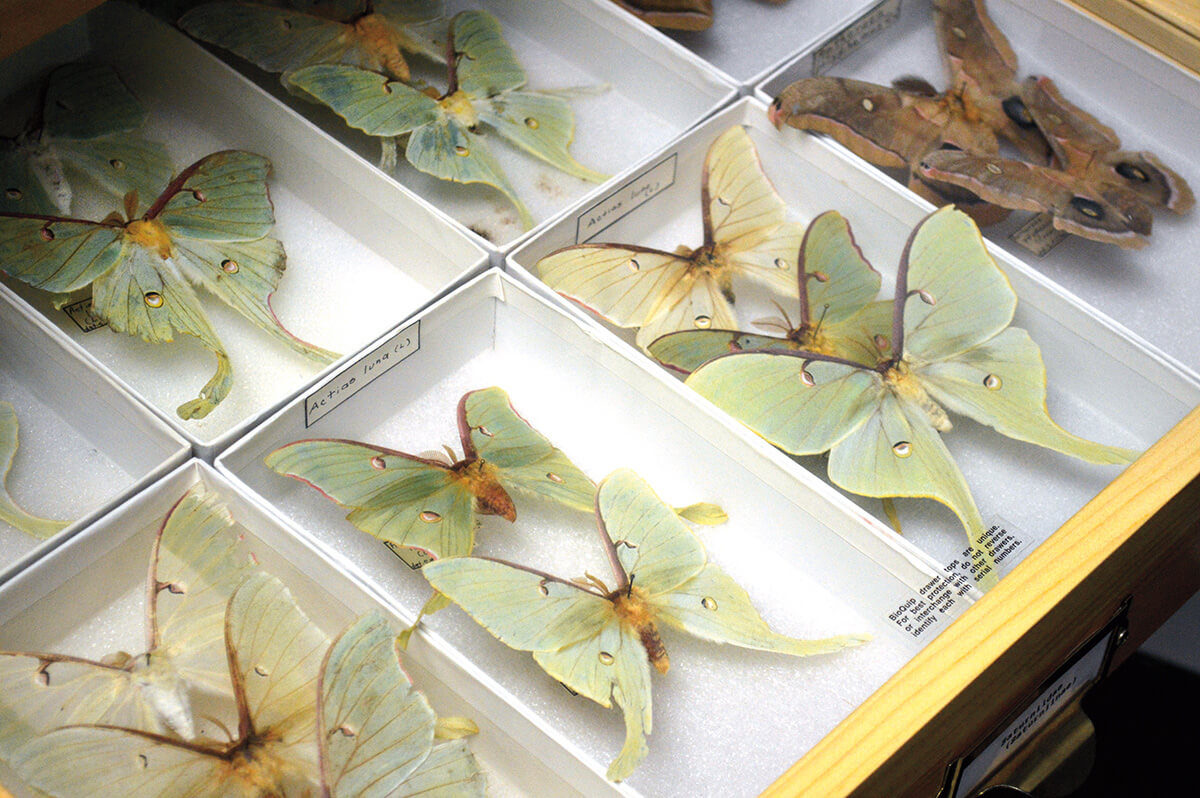
Despite its unassuming appearance, the West Virginia Department of Agriculture Insect Collection is a trove of interesting critters.
There is a room, in a white rectangular building perched on a hilltop just 10 minutes outside Charleston, where you can find crowds of cockroaches, hordes of hard-shelled beetles, and multitudes of mosquitoes and moths. There are house flies and fruit flies, ants and lightning bugs, and just about any other creepy-crawly you’ve ever seen—as well as plenty more you’ve never even noticed.
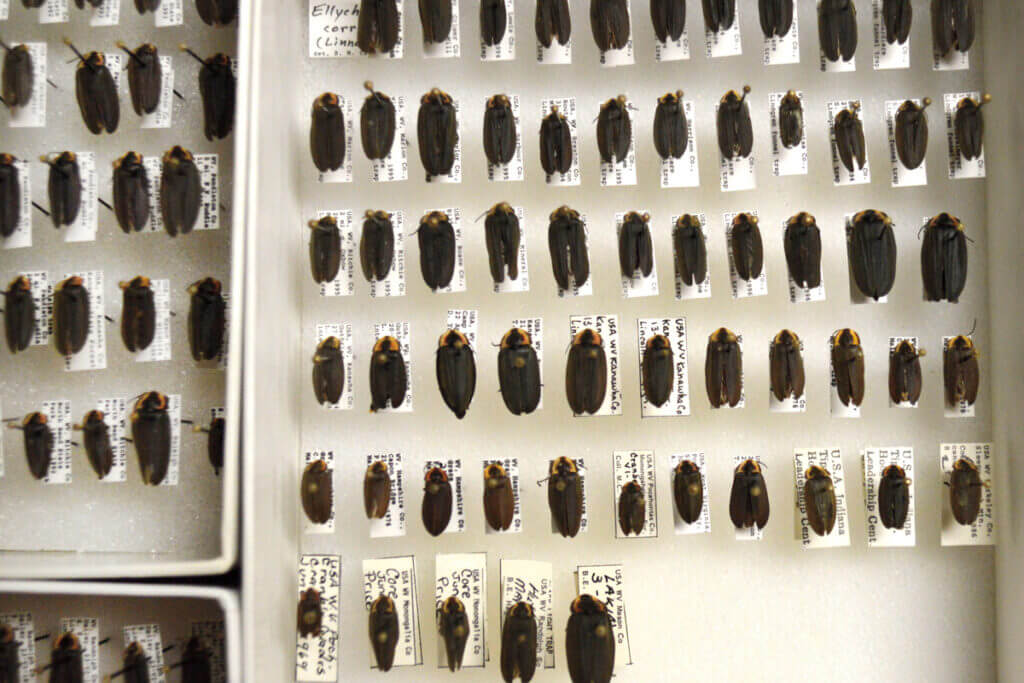
It could be an entomophobe’s worst nightmare. This one room contains more than a quarter million insects. You could say the place is crawling with bugs—except, they don’t crawl anymore.
Welcome to the West Virginia Department of Agriculture Insect Collection, located at the agency’s compound in Guthrie. It’s the largest such collection of native insects in the state. “I like to call it a museum, but that’s not the official name,” says curator Laura Miller, a taxonomic entomologist with the department’s plant industries division. She also compares the collection to a library. “It’s a library with insects instead of books.”
The room, with its government-issue drop ceiling and fluorescent lights, is filled with rows of wood-veneered cabinets organized by evolutionary families. Pulling out the glass-topped drawers reveals row upon row of brightly colored butterflies, gossamer-winged moths, and shiny beetles—including the Desmocerus palliatus, a blue and gold bug that is the official mascot of the West Virginia Entomological Society. “Kids come here and say, ‘Are they all dead?!'” Miller says.
Other species appear less impressive to the naked eye, but these are Miller’s favorites. “The small stuff, it’s intriguing. You put it under the microscope and … they have so much stuff going on.” On closer inspection, even the most boring-looking insects pop with brilliant coloring, intricate patterns, and impressive anatomies.
The bug museum is a lot like the creatures it contains, in that way. It might not look like much at first glance, but keep digging and you’re sure to find something interesting.
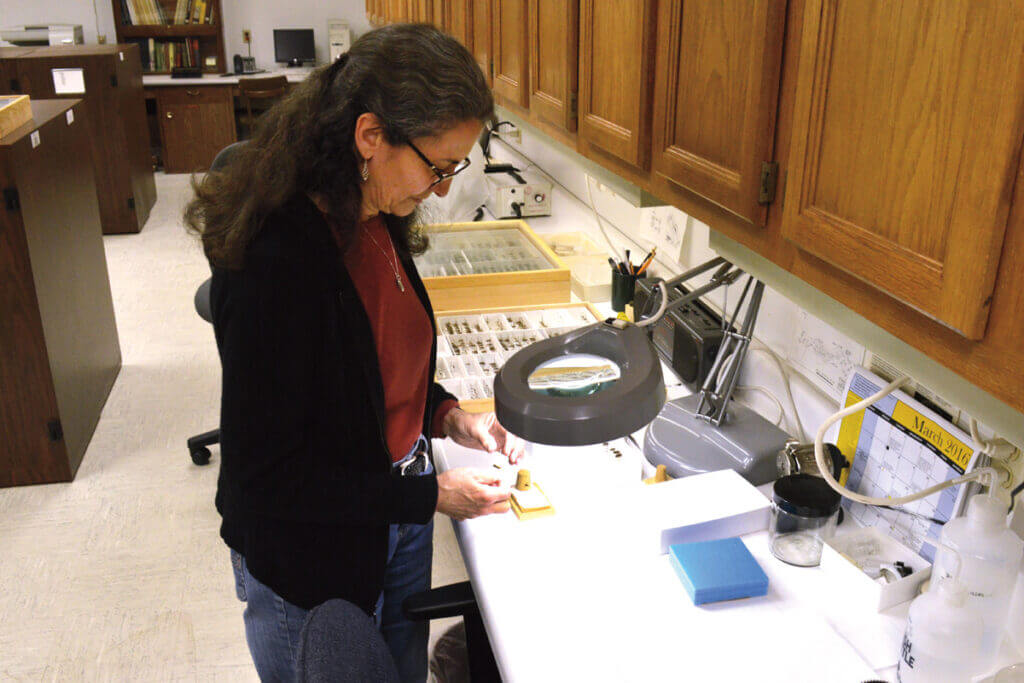
Keeper of the Creepy Crawlies
Bugs brought Miller to West Virginia. A native of Mexico, she moved to the United States to study lace bugs at the Smithsonian Institution. She married a West Virginia boy, then attended Marshall University for her master’s degree. She was giving a presentation on lace bugs at the West Virginia Academy of Sciences when she met someone from the agriculture department, who encouraged her to submit her resume. She began as a part-time technician, then spent several years doing survey work before taking a job as a taxonomic entomologist and the bug museum’s curator.
Now, whenever she gets time away from her other duties, Miller spends her days tending to the insect collection. New specimens arrive frequently, collected by department entomologists in the field. Once the bugs are caught, killed, and pinned, it’s up to Miller to identify the insects and sort them accordingly.
It is slow, exacting work. “It’s like knitting,” she says. “Except, you can’t watch TV.” It’s also a never-ending project. Many of the cabinets have drawers of pinned bugs stacked on top, waiting for Miller or someone else to identify their exact species. To date, only about half of the museum’s 250,000 bugs have been identified by species.
“I always make the comparison—you have bird field guides or flower guides where you have pictures and you can say, ‘Oh, that’s what it is.’ There’s no such thing for insects,” she says. There are more insects in the world than any other kind of animal—around 10 quintillion, by some estimates. And because each family of insects is unique, just identifying them requires an expert’s eye.
Using special identification guides, Miller scrutinizes each part of an insect under a microscope to determine its species. Even details as minute as the veins on a wasp’s wing can mean the difference between one classification and another. “It’s mind-boggling, really,” Miller says. “Sometimes it can take me a whole day to identify something, just one specimen.”
She often relies on the expertise of other taxonomists with different specialty areas to identify the bugs. This is becoming increasingly necessary as more and more non-native species invade West Virginia’s borders.
Recently, a lumberyard employee sent Miller a bark beetle because it looked a little different than usual. She hasn’t identified the bug yet, but there’s a possibility it could be a new arrival to the state. “Sometimes we find new things. It doesn’t happen often, but it happens,” she says.
Miller also is vigilant about keeping unwanted bugs out of the collection. She is constantly on the lookout for tiny insects commonly called “dermestid beetles.” These are the same beetles taxidermists and forensic scientists use to nibble away the tissue from the bones of animal remains. The adult beetles feed on flowers and shrubs. But in their larval stage, they love to munch on dry pieces of skin, food, wood—as well as the dried remains of other bugs, which makes the insect museum a veritable feast for the gluttonous scarabs.
Miller says the dermestid larvae often sneak into the museum by hitching a ride on specimens that are loaned out to researchers. Sometimes adult beetles even lay eggs inside the dried bugs, so the larvae do not hatch until the specimens are back in Miller’s safekeeping. “This is the panic of any insect museum. They completely destroy your insects,” she says.
To combat the problem, loaned-out drawers spend a few days in a freezer to kill any stowaways. Miller also keeps tiny red squares of pesticide paper tacked inside the drawers and a log sheet taped to each cabinet door to track when the pesticide was last replaced.
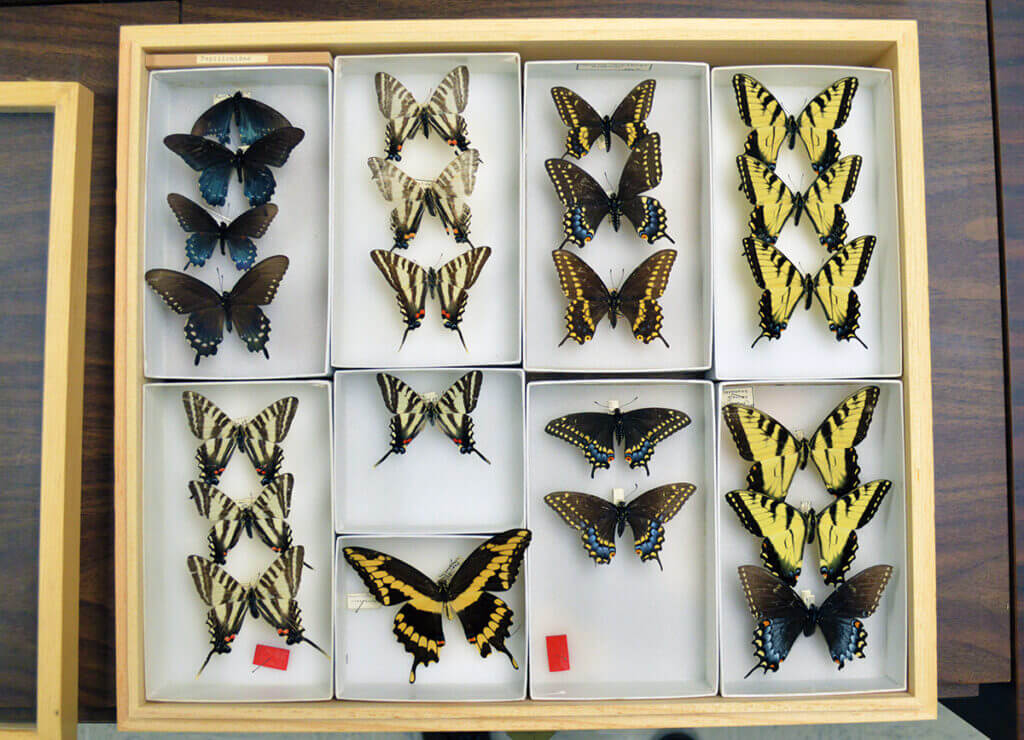
A Community Resource
Although the West Virginia Department of Agriculture Insect Collection isn’t a museum in the popular sense, with fancy interactive exhibits and a gift shop, it is still very much a public institution.
It’s not a rare occurrence for a high school or college student to set up an appointment to use the collection for a school project. Agriculture department outreach specialists often borrow drawers of the more impressive-looking specimens to take to local elementary schools. Miller herself uses the collection when she teaches insect classes for students in the West Virginia Division of Natural Resources’ Master Naturalist Program.
During the course, which is required for all graduates of the program, Miller provides a quick overview of the life cycle of bugs, why they’re so abundant on Earth, and information about different classes of insects and the features that make them unique. “It’s just to give them a little brush-up of different things, and the rest is pretty much on their own,” she says.
There’s just too much to learn, even about the bugs that reside in West Virginia, to cover in a four-hour class. Miller has been studying insects since the 1980s and still has only scratched the surface. She’s well aware her work at the bug museum will never be complete—that’s one thing she likes about it. “As a taxonomist, this is almost like a dream come true.”
This story was originally published in the January 2017 issue of Wonderful West Virginia magazine. To subscribe, visit wonderfulwv.com.
Written and photographed by Zack Harold




